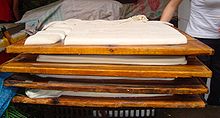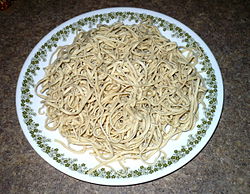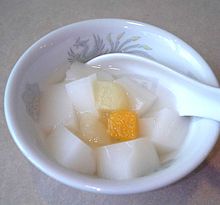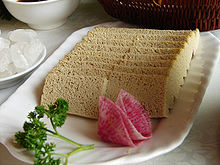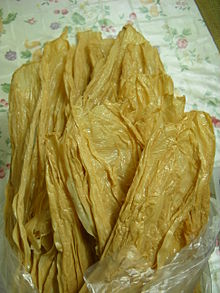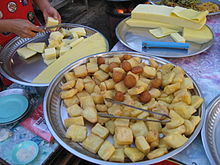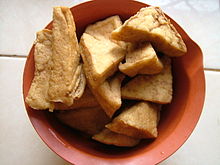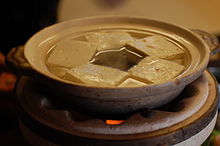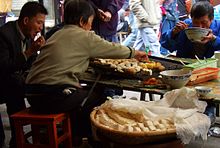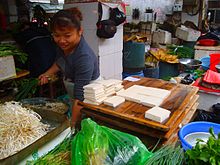
Tofu
Background Information
SOS Children, which runs nearly 200 sos schools in the developing world, organised this selection. SOS Children has looked after children in Africa for forty years. Can you help their work in Africa?
| Tofu | |||||||||||||||||||||||||||
|---|---|---|---|---|---|---|---|---|---|---|---|---|---|---|---|---|---|---|---|---|---|---|---|---|---|---|---|
 |
|||||||||||||||||||||||||||
| Silken tofu (Kinugoshi tōfu in Japanese) | |||||||||||||||||||||||||||
| Chinese name | |||||||||||||||||||||||||||
| Traditional Chinese | 荳腐 or 豆腐 | ||||||||||||||||||||||||||
| Simplified Chinese | 豆腐 | ||||||||||||||||||||||||||
| Hanyu Pinyin | dòufu | ||||||||||||||||||||||||||
| Literal meaning | bean curd | ||||||||||||||||||||||||||
|
|||||||||||||||||||||||||||
| Vietnamese name | |||||||||||||||||||||||||||
| Vietnamese | đậu phụ or đậu hũ or tàu hũ |
||||||||||||||||||||||||||
| Thai name | |||||||||||||||||||||||||||
| Thai | เต้าหู้, IPA: [tâohûː] | ||||||||||||||||||||||||||
| Korean name | |||||||||||||||||||||||||||
| Hangul | 두부 | ||||||||||||||||||||||||||
| Hanja | 豆腐 | ||||||||||||||||||||||||||
|
|||||||||||||||||||||||||||
| Japanese name | |||||||||||||||||||||||||||
| Kanji | 豆腐 | ||||||||||||||||||||||||||
| Hiragana | とうふ (tōfu) | ||||||||||||||||||||||||||
|
|||||||||||||||||||||||||||
| Malay name | |||||||||||||||||||||||||||
| Malay | tauhu | ||||||||||||||||||||||||||
| Filipino name | |||||||||||||||||||||||||||
| Tagalog | tokwa | ||||||||||||||||||||||||||
| Tamil name | |||||||||||||||||||||||||||
| Tamil | தஹு (tahu) | ||||||||||||||||||||||||||
| Min Bei name | |||||||||||||||||||||||||||
| Min Bei | dae fu ( Jian'ou dialect) | ||||||||||||||||||||||||||
| Indonesian name | |||||||||||||||||||||||||||
| Indonesian | tahu | ||||||||||||||||||||||||||
Tofu, also called bean curd, is a food made by coagulating soy juice and then pressing the resulting curds into soft white blocks. It is a component in many East Asian and Southeast Asian cuisines. There are many different varieties of tofu, including fresh tofu and tofu that has been processed in some way. Tofu has a subtle flavor and can be used in savory and sweet dishes. It is often seasoned or marinated to suit the dish.
Tofu originated in ancient China some 2,000 years ago. Chinese legend ascribes its invention to prince Liu An (Chinese: 劉安 Liú Ān, 179–122 BC). Tofu and its production technique were introduced into Korea and then Japan during the Nara period. It spread into other parts of East Asia as well. This spread likely coincided with the spread of Buddhism because it is an important source of protein in the vegetarian diet of East Asian Buddhism. Li Shizhen in the Ming Dynasty described a method of making tofu in Bencao Gangmu.
Tofu has a low calorie count, relatively large amounts of protein, and little fat. It is high in iron and depending on the coagulant used in manufacturing, may also be high in calcium and/or magnesium.
Etymology
The English word "tofu" comes from the Japanese tōfu (豆腐), which itself derives from the Chinese dòufu (豆腐 or 荳腐) from "bean" ( 豆) plus "curdled" or "fermented" ( 腐).
The term "bean curd(s)" for tofu has been used in the United States since at least 1840. It is not frequently used, however, in the United Kingdom, Australia or New Zealand.
Production
| Nutritional value per 100 g (3.5 oz) | |
|---|---|
| Energy | 70 kcal (290 kJ) |
| Carbohydrates | 1.5 g |
| Fat | 3.5 g |
| - saturated | 0.5 g |
| Protein | 8 g |
| Calcium | 130 mg (13%) |
| Iron | 1.10 mg (8%) |
| Sodium | 4 mg (0%) |
| Percentages are relative to US recommendations for adults. Source: USDA Nutrient Database |
|
Tofu is made by coagulating soy milk and pressing the resulting curds. Although pre-made soy milk may be used, most tofu producers begin by making their own soy milk, which is produced by soaking, grinding, boiling and straining dried (or, less commonly, fresh) soybeans.
Coagulation of the protein and oil ( emulsion) suspended in the boiled soy milk is the most important step in the production of tofu. This process is accomplished with the aid of coagulants. Two types of coagulants (salts and acids) are used commercially. The third type of coagulant, enzymes, is not yet used commercially but shows potential for producing both firm and "silken" tofu.
Salt coagulants
- Calcium sulfate (gypsum): The traditional and most widely used coagulant to produce Chinese-style tofu. It produces a tofu that is tender but slightly brittle in texture. The coagulant itself has no perceivable taste. Use of this coagulant also makes a tofu that is rich in calcium. As such, many tofu manufacturers choose to use this coagulant to be able to market their tofu as a good source of dietary calcium.
- Chloride-type Nigari salts or Lushui ( Traditional: 鹵水, 滷水; Simplified: 卤水, lǔshuǐ) - Magnesium chloride and calcium chloride: Both of these salts have a high solubility rate in water and affect soy protein in the same way, whereas gypsum is only very slightly soluble in water and acts differently in soy protein precipitation, the basis for tofu formation. These are the coagulants used to make tofu with a smooth and tender texture. In Japan, a white powder called nigari, which consists primarily of magnesium chloride, is produced from seawater after the sodium chloride is removed and the water evaporated. Depending on its production method, nigari/Lushui may also contain small quantities of magnesium sulfate (Epsom salt), potassium chloride, calcium chloride, and trace amounts of other naturally occurring salts. Although the term nigari is derived from nigai, the Japanese word for "bitter," neither nigari nor pure magnesium chloride imparts a perceivable taste to the finished tofu. Calcium chloride is a common coagulant for tofu in North America. Fresh clean sea water itself can also be used as a coagulant.
Acid coagulants
- Glucono delta-lactone (GDL): A naturally occurring organic acid also used in cheese making, which produces a very fine textured tofu that is almost jelly-like. This coagulant is used especially for "silken" and softer tofus, and confers an almost imperceptible sour taste to the finished product. Commonly used together with calcium sulfate to give soft tofu a smooth tender texture.
- Other edible acids: Though they can affect the taste of the tofu more, and vary in efficacy and texture, acids such as acetic acid (vinegar) and citric acid (such as lemon juice), can also be used to coagulate soy milk and produce tofu.
Enzyme coagulants
- Among enzymes that have been shown to produce tofu are papain, and alkaline and neutral proteases from microorganisms. In the case of papain, the enzyme to substrate ratio, by weight, was held constant at 1:400. An aliquot of 1% crude papain was added to "uncooked" soy milk at room temperature and heated to 90–100 °C.
Contemporary tofu manufacturers may choose to use one or more of these coagulants, since they each play a role in producing a desired texture in the finished tofu. Different textures result from different pore sizes and other microscopic features in tofus produced using each coagulant. The coagulant mixture is dissolved into water, and the solution is then stirred into boiled soy milk until the mixture curdles into a soft gel.
The curds are processed differently depending on the form of tofu that is being manufactured. For soft silken tofu ( 嫩 豆 腐; nèn dòufu) or tofu flower ( 豆 花, dòuhuā) the soy milk is curdled directly in the tofu's selling package. For standard firm Asian tofu, the soy curd is cut and strained of excess liquid using cheese cloth or muslin and then lightly pressed to produce a soft cake. Firmer tofus, such as Asian dry tofu ( 豆 干) or Western types of tofu, are further pressed to remove even more liquid. In Vietnam, the curd is strained and molded in a square mold and the end product is called đậu khuôn (molded bean) or đậu phụ (one of the Vietnamese ways to pronounce the Chinese dòufu). The tofu curds are allowed to cool and become firm. The finished tofu can then be cut into pieces, flavored or further processed.
Although tartness is sometimes desired in dessert tofu, the acid used in flavoring is usually not the primary coagulant since it is not desirable to the flavor or texture of the resulting tofu to add it in a sufficiently high concentration so as to induce coagulation. A sour taste in tofu and a slight cloudiness in its storing liquid is also usually an indication of bacterial growth and, hence, spoilage.
Varieties
There is a wide variety of tofu available in both Western and Eastern markets. Despite the large variety, tofu products can be split into two main categories: fresh tofu, which is produced directly from soy milk, and processed tofu, which is produced from fresh tofu. Tofu production also creates important side products which are often used in various cuisines.
Fresh tofu
Depending on the amount of water that is extracted from the tofu curds, fresh tofu can be divided into three main varieties. Fresh tofu is usually sold completely immersed in water to maintain its moisture content.
Soft/silken tofu
Soft/silken tofu (嫩豆腐 or 滑豆腐, nèn dòufu or huá dòufu, in Chinese, lit. "soft tofu" or "smooth tofu"; 絹漉し豆腐, kinugoshi tōfu in Japanese, lit. "silk-filtered tofu"; 순두부, 純豆腐, sundubu in Korean, lit. "pure tofu") is undrained, unpressed tofu that contains the highest moisture content of all fresh tofus. Its texture can be described as similar to that of very fine custard. Silken tofu is produced by coagulating soy milk without curdling it. Silken tofu is available in several consistencies, including "soft" and "firm", but all silken tofu is more delicate than regular firm tofu (pressed tofu) and has different culinary uses. In Japan and Korea, traditional soft tofu is made with seawater.
Douhua (豆花, dòuhuā or 豆腐花, dòufuhuā in Chinese), or tofu brain (豆腐腦 or 豆腐脑, dòufunaǒ in Chinese), often eaten as a dessert, but sometimes with salty pickles or hot sauce added instead, is another type of soft tofu with an even higher moisture content. Because it is very difficult to pick up this type of tofu with chopsticks, it is generally eaten with a spoon. With the addition of flavorings such as finely chopped spring onions, dried shrimp, soy sauce, chilli sauce, douhua is a popular breakfast dish across China. In Malaysia, douhua is usually served warm with white or dark (palm) sugar syrup, or served cold with longans.
Some variation exists among soft tofus. Black douhua (黑豆花, hēidòuhuā) is a type of silken tofu made from black soybeans, which is usually made into dòuhuā ( 豆 花) rather than firm or dry tofu. The texture of black bean tofu is slightly more gelatinous than regular douhua and the colour is greyish in tone. This type of tofu is eaten for the earthy "black bean taste." Edamame tofu is a Japanese variety of kinugoshi tōfu made from edamame (fresh green soybeans); it is pale green in colour and often studded with whole edamame.
Firm tofu
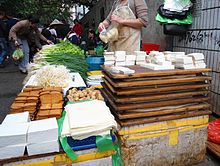
Firm tofu (called 老豆腐 lǎo dòufu in Chinese; 木綿豆腐, momen-dōfu in Japanese, lit. "cotton tofu"): Although drained and pressed, this form of fresh tofu still contains a great amount of moisture. It has the firmness of raw meat but bounces back readily when pressed. The texture of the inside of the tofu is similar to that of a firm custard. The skin of this form of tofu has the pattern of the muslin used to drain it and is slightly more resilient to damage than its inside. It can be picked up easily with chopsticks.
In some places in Japan, a very firm type of momen-dōfu is eaten, called ishi-dōfu (石豆腐; literally stone tofu) in a parts of Ishikawa, or iwa-dōfu (岩豆腐; literally rock tofu) in Gokayama in the Toyama prefecture and in the Iya in the prefecture of Tokushima. Due to their firmness, some of these tofu can be tied by rope and carried. These types of firm tofu are produced with seawater instead of nigari ( magnesium chloride), or using concentrated soy milk. Some of them are squeezed of excess moisture using heavy weights. These products are produced in areas where travelling is inconvenient, such as remote islands, mountain villages, heavy snowfall areas, and so on.
Extra firm tofu
Dòu gān (豆干, literally "dry tofu" in Chinese) is an extra firm variety of tofu where a large amount of liquid has been pressed out of the tofu. Dòu gān contains the least amount of moisture of all fresh tofu and has the firmness of fully cooked meat and a somewhat rubbery feel similar to that of paneer. When sliced thinly, this tofu can be crumbled easily. The skin of this form of tofu has the pattern of the muslin used to drain and press it. Western firm tofu is milled and reformed after the pressing and sometimes lacks the skin with its cloth patterning. One variety of dried tofu is pressed especially flat and sliced into long strings with a cross section smaller than 2 mm × 2 mm. Shredded dried tofu (豆干絲, dòugānsī in Chinese, or simply 干絲, gānsī), which looks like loose cooked noodles, can be served cold, stir-fried, or similar in style to Japanese aburaage.
Processed tofu
Many forms of processed tofus exist, due to the varied ways in which fresh tofu can be used. Some of these techniques likely originate from the need to preserve tofu before the days of refrigeration, or to increase its shelf life and longevity. Other production techniques are employed to create tofus with unique textures and flavours.
Fermented
- Pickled tofu ( 豆 腐 乳 in Chinese, pinyin: dòufurǔ, lit. "tofu dairy," or 腐 乳 fùrǔ; chao in Vietnamese): Also called "preserved tofu" or "fermented tofu," this food consists of cubes of dried tofu that have been allowed to fully air-dry under hay and slowly ferment from aerial bacteria. The dry fermented tofu is then soaked in salt water, Chinese wine, vinegar, and minced chiles, or a unique mixture of whole rice, bean paste, and soybeans. In the case of red pickled tofu ( 紅 豆 腐 乳 in Chinese, Pinyin: hóng dòufurǔ), red yeast rice (cultivated with Monascus purpureus) is added for colour. And in Japan, pickled tofu with miso paste is called "tofu no misodzuke," which is a traditional preserved food in Kumamoto. In Okinawa, there is a pickled and fermented tofu called "tofuyo"(豆腐餻). It is made from "Shima-doufu" (an Okinawan variety of large and firm tofu). It is fermented, and matured with koji mold, red koji mold, and awamori.
- Stinky tofu ( 臭 豆 腐 in Chinese, Pinyin: chòudòufu): A soft tofu that has been fermented in a unique vegetable and fish brine. The blocks of tofu smell strongly of certain pungent cheeses, and are described by many as rotten and fecal. Despite its strong odour, the flavor and texture of stinky tofu is appreciated by aficionados, who describe it as delightful. The texture of this tofu is similar to the soft Asian tofu that it is made from. The rind that stinky tofu develops from frying is said to be especially crisp, and is usually served with soy sauce, sweet sauce, and/or hot sauce.
Flavored
Flavours can be mixed directly into curdling soy milk while the tofu is being produced.
- Sweet: Common sweet dessert tofus include peanut tofu (落花生豆腐, luòhuāshēng dòufu in Chinese and jimami-dōfu in Japanese), almond tofu (杏仁豆腐, xìngrén dòufu in Chinese; 杏仁豆腐, annindōfu in Japanese), mango tofu, coconut tofu and longan tofu (龙眼豆花). In order to produce these forms of tofu, sugar, fruit acids, and flavorants are mixed into soy milk prior to curdling. Most sweet tofus have the texture of silken tofu and are served cold.
- Products called "almond tofu" in some cases are actually not tofu but are instead gelatinous mixtures including agar or gelatin and whitened with milk or coconut milk. In Japan these are canned with syrup and sold as sweet desserts.
- Savory: Egg tofu (Japanese: 玉子豆腐, 卵豆腐, tamagodōfu) (Chinese: 蛋豆腐, dàn dòufu; often called 日本豆腐, rìbĕn dòufu, lit. "Japan bean curd") is the main type of savory flavored tofu. Whole beaten eggs are filtered and incorporated into the soy milk before the coagulant is added. The mixture is filled into plastic tubes and allowed to curdle. The tofu is then cooked in its packaging and sold. Egg tofu has a pale golden colour that can be attributed to the addition of egg and, occasionally, food coloring. This tofu has a fuller texture and flavor than silken tofu, which can be attributed to the presence of egg fat and protein. Plain "dried tofu" can be flavored by stewing in soysauce (滷) to make soysauce tofu. It is quite common to see tofu sold in market in this soy-sauce stewed form.
Dried tofu
Two kinds of dried tofu are produced in Japan. They are usually rehydrated (by being soaked in water) prior to consumption. In their dehydrated state they do not require refrigeration.
- Koya tofu (also known as shimidofu) is made using nigari.
- Kori tofu (literally "frozen tofu") is freeze-dried.
Fried
- With the exception of the softest tofus, all forms of tofu can be fried. Thin and soft varieties of tofu are deep fried in oil until they are light and airy in their core ( 豆 泡 dòupào, 豆腐泡 dòufupào, 油豆腐 yóudòufu, or 豆 卜 dòubǔ in Chinese, literally "bean bubble," describing the shape of the fried tofu as a bubble).
- Tofus such as firm Asian and dòu gān (Chinese dry tofu), with their lower moisture content, are cut into bite-sized cubes or triangles and deep fried until they develop a golden-brown, crispy surface ( 炸 豆腐 in Chinese, zhádòufu, lit. "fried tofu"). These may be eaten on their own or with a light sauce, or further cooked in liquids; they are also added to hot pot dishes or included as part of the vegetarian dish called luohan zhai. This deep fried tofu is also called Atsuage (厚揚げ) or Namaage (生揚げ) in Japan. The thinner variety is called Aburaage (油揚げ) which develops a tofu pouch when fried that is often used for Inari-sushi.
Frozen
- Thousand layer tofu ( 千 葉 豆 腐, 凍 豆 腐 dòngdòufu or 冰 豆 腐 bīngdòufu in Chinese, literally "thousand layer tofu" or "frozen tofu"): By freezing tofu, the large ice crystals that develop within the tofu result in the formation of large cavities that appear to be layered. The frozen tofu takes on a yellowish hue in the freezing process. Thousand layer tofu is commonly made at home from Asian soft tofu though it is also commercially sold as a specialty in parts of Taiwan. This tofu is defrosted, and sometimes pressed to remove moisture, prior to use.
- Koya-dofu (kōya-dōfu, 高 野 豆 腐 in Japanese): The name comes from Mount Koya, a centre of Japanese Buddhism famed for its shōjin ryōri, or traditional Buddhist vegetarian cuisine. It is sold in freeze-dried blocks or cubes in Japanese markets. It must be soaked in water before eating, and is typically simmered in dashi, sake or mirin and soy sauce. In shōjin ryōri, vegetarian kombu dashi, made from seaweed, is used. When prepared in the usual manner, it has a spongy texture and mild sweet and savory flavor. A similar form of freeze-dried tofu, in smaller pieces, is found in instant soups (such as miso soup), in which the toppings are freeze-dried and stored in sealed pouches.
Tofu is also a main dish, especially this type which is commonly used and is in high demand in eastern Asia.
Byproducts of tofu production
Tofu production creates some edible byproducts. Food products are made from the protein-oil film, or "skin," which forms over the surface of boiling soy milk in an open shallow pan. The leftover solids from pressing soy milk are called okara.
Tofu skin
Tofu skin is produced through the boiling of soy milk, in an open shallow pan, thus producing a film or skin composed primarily of a soy protein-lipid complex on the liquid surface. The films are collected and dried into yellowish sheets known as soy milk skin (腐皮, fǔpí in Chinese; 湯葉, yuba in Japanese). Its approximate composition is : 50–55% protein, 24–26% lipids (fat), 12% carbohydrate, 3% ash, and 9% moisture.
The skin can also be bunched up to stick form and dried into something known as "tofu bamboo" (腐竹, fǔ zhú in Chinese; phù trúc in Vietnamese; kusatake, Japanese), or myriad other forms. Since tofu skin has a soft yet rubbery texture, it is folded or shaped into different forms and cooked further to imitate meat in vegan cuisine.
Some factories dedicate production to tofu skin and other soy membrane products.
Okara
Okara (おから) (雪花菜, xuěhuācaì, lit. "snowflake vegetable"; 豆腐渣, dòufuzhā, lit. "tofu sediment/residue"; kongbiji, 콩비지 in Korean), sometimes known in the west as "soy pulp" or "tofu lees", is the fibre, protein, and starch left over when soy milk has been extracted from ground soaked soybeans. Although it is mainly used as animal feed in most tofu producing cultures, it is sometimes used in Japanese and Korean cuisines. It is also an ingredient for vegetarian burgers produced in many western nations.
Non-tofu "tofus"
Due to their Asian origins and their textures, many food items are called "tofu" even though their production processes are not technically similar. For instance, many sweet almond tofus are actually gelatinous desserts made from agar or gelatin and whitened with milk or coconut milk more similar to Japanese anmitsu. As well, some foods such as Burmese tofu are not coagulated from the "milk" of the legume but rather set in a manner similar to soft polenta, Korean muk, or the jidou liangfen of Yunnan province of Southwest China.
Burmese tofu
Burmese tofu (to hpu in Burmese) is a type of legume product made from besan ( chana dal) flour; the Shan variety uses yellow split pea flour instead. Both types are yellow in colour and generally found only in Myanmar, though the Burman variety is also available in some overseas restaurants serving Burmese cuisine.
Burmese tofu may be fried as fritters cut in rectangular or triangular shapes. Rice tofu, called hsan to hpu (or hsan ta hpo in Shan regions) is made from rice flour (called hsan hmont or mont hmont) and is white in colour, with the same consistency as yellow Burmese tofu when set. It is eaten as a salad in the same manner as yellow tofu.
Preparation
Tofu has very little flavor or smell on its own. Consequently tofu can be prepared either in savory or sweet dishes, acting as a bland background for presenting the flavours of the other ingredients used. As a method of flavoring it is often marinated in soy sauce, chilis, sesame oil, etc.
Eastern methods
In Asian cooking, tofu is eaten in myriad ways, including raw, stewed, stir-fried, in soup, cooked in sauce, or stuffed with fillings. The idea of using tofu as a meat substitute is not common in East Asia. Many Chinese tofu dishes such as jiācháng dòufu (家常豆腐)and mápó dòufú ( 麻婆豆腐) include meat.
Lightly flavored
In Japan, a common lunch in the summer months is hiyayakko ( 冷 奴), silken or firm Asian tofu served with freshly grated ginger, green onions, and/or katsuobushi shavings with soy sauce. In the winter, tofu is frequently eaten as "yudofu," which is simmered in a claypot with some vegetables (ex: chinese cabbage, green onion etc.) using konbu dashi.
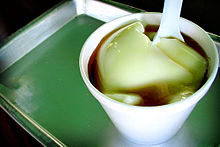
In Chinese cuisine, Dòuhuā ( 豆 花) is served with toppings like boiled peanuts, azuki beans, cooked oatmeal, tapioca, mung beans and a syrup flavored with ginger or almond. During the summer, "dòuhuā" is served with crushed ice; in the winter, it is served warm. And also, in many parts of China, fresh tofu is similarly eaten with soy sauce or further flavored with " katsuobushi" shavings, century eggs ( 皮 蛋 pídàn), and sesame seed oil.
In Korean cuisine, dubu gui (두부구이) consists of pan fried cubes of firm tofu, seasoned with soy sauce, garlic, and other ingredients. Cubes of cold, uncooked firm tofu seasoned with soy sauce, scallions, and ginger, prepared in a manner similar to the Japanese hiyayakko, are also enjoyed. The popular bar food, or anju (안주), called dubu kimchi (두부김치), features boiled, firm tofu served in rectangular slices around the edges of a plate with pan fried, sautéed or freshly mixed kimchi (김치) in the middle.
In the Philippines, the sweet delicacy taho is made of fresh tofu with brown sugar syrup and sago. The Malaysian version of taho or douhua is called tofufa. Warm soft tofu is served in "slices" (due to being scooped using a flat spoon from a wooden bucket) in a bowl with either pandan-flavored sugar syrup or palm sugar syrup.
In Vietnam, dòuhuā is pronounced đậu hủ. This variety of soft tofu is made and carried around in an earthenware jar. It is served by being scooped into a bowl with a very shallow and flat spoon, and eaten with either powdered sugar and lime juice or with a ginger-flavored syrup. It is generally eaten hot, even during summer.
Fried
A common cooking technique in many parts of East and Southeast Asia involves deep frying tofu in vegetable oil, sunflower oil, and canola oil to varied results. In Indonesia, it is usually fried in palm oil. Although tofu is often sold preprocessed into fried items, pre-fried tofu is seldom eaten directly and requires additional cooking. Depending on the type of tofu used, the texture of deep fried tofu may range from crispy on the outside and custardy on the inside, to puffed up like a plain doughnut. The former is usually eaten plain in Chinese cuisine with garlic soy sauce, while the latter is either stuffed with fish paste or cooked in soups. In Japan, cubes of lightly coated and fried tofu topped with a kombu dashi-based sauce are called agedashi-dofu (揚げ出し豆腐). Soft tofu that has been thinly sliced and deep fried, known as aburage in Japan and yubu (유부) in Korea, is commonly blanched, seasoned with soy sauce and mirin and served in dishes such as kitsune udon. Aburage is sometimes also cut open to form a pocket and stuffed with sushi rice; this dish is called inarizushi (稲荷寿司) and is also popular in Korea, where it is called yubu chobap (유부초밥). In Indonesia, tofu is called tahu, and the popular fried tofu is tahu goreng, tahu isi and tahu sumedang.
Soups, stews, and braised dishes
A rather famous hot Sichuan preparation using firm Asian tofu is mápó dòufu ( 麻 婆 豆 腐). This involves braised tofu in a beef, chili, and a fermented bean paste sauce. In the Shanghai region it is called málà dòufu ( 麻 辣 豆 腐).
Dried tofu is usually not eaten raw but first stewed in a mixture of soy sauce and spices. Some types of dried tofu are preseasoned with special blends of spices, so that the tofu may either be called "five spice tofu" (五香豆腐 wǔxiāng dòufu) or "soy sauce stewed tofu" (鹵水豆腐 lǔshuǐ dòufu). Dried tofu is typically served thinly sliced with chopped green onions or with slices of meat for added flavor. Most dried tofu is sold after it has been fried or pre-stewed by tofu vendors.
Soft tofu can also be broken up or mashed and mixed with raw ingredients prior to being cooked. For example, Japanese ganmodoki is a mixture of chopped vegetables and mashed tofu. The mixture is bound together with starch and deep fried. Chinese families sometimes make a steamed meatloaf or meatball dish from equal parts of coarsely mashed tofu and ground pork. In India, tofu is also used as a low fat replacement for paneer providing the same texture with similar taste.
Tofu bamboos are often used in lamb stew or in a dessert soup. Tofu skins are often used as wrappers in dim sum. Freeze-dried tofu and frozen tofu are rehydrated and enjoyed in savory soups. These products are often taken along on camping trips since a small bag of these dried tofu can provide protein for many days.
Japanese ' miso soup', stocks with miso paste, is frequently made with tofu.
In Korean cuisine, soft tofu, called sundubu (순두부), is used to make a thick stew called sundubu jjigae (순두부 찌개). Firm, diced tofu often features in the staple stews doenjang jjigae (된장 찌개) and kimchi jjigae (김치 찌개).
Bacem
Bacem is a method of cooking tofu originating from Java, Indonesia. The tofu is boiled in coconut water, mixed with lengkuas (galangal), Indonesian bay leaves, coriander, shallot, garlic, tamarind and palm sugar. After the spicy coconut water has completely evaporated, the tofu is fried until it is golden brown. The result is sweet, spicy, and crisp. This cooked tofu variant is commonly known as tahu bacem in Indonesian. Tahu bacem is commonly prepared along with tempeh and chicken.
As flavoring
Pickled tofu is commonly used in small amounts together with its soaking liquid to flavor stir-fried or braised vegetable dishes (particularly leafy green vegetables like water spinach). It is often eaten directly as a condiment with rice or congee.
Western methods
Generally, the firmer styles of tofu are used for kebabs, mock meats, and dishes requiring a consistency that holds together, while the softer styles can be used for desserts, soups, shakes, and sauces.
Firm western tofus can be barbecued since they will hold together on a barbecue grill. These types of tofu are usually marinated overnight as the marinade does not easily penetrate the entire block of tofu (techniques to increase penetration of marinades are stabbing repeatedly with a fork or freezing and thawing prior to marinating). Grated firm western tofu is sometimes used in conjunction with TVP as a meat substitute. Softer tofus are sometimes used as a dairy-free or low-calorie filler. Silken tofu may be used to replace cheese in certain dishes (such as lasagna).
Tofu has also been fused into other cuisines in the west, for instance used in Indian-style curries.
Tofu and soy protein can be industrially processed to match the textures and flavours to the likes of cheese, pudding, eggs, bacon etc. Tofu's texture can also be altered by freezing, pureeing, and cooking. In the Americas, Europe, Australia and New Zealand, tofu is frequently associated with vegetarianism and veganism as it is a source of non-animal protein.
History
Tofu originated in ancient China, although little else is known about the exact historic origins of tofu and of its method of production. While there are many theories regarding tofu's origins, historical information is scarce enough as to relegate the status of most theories to either speculation or legend. Like the origins of cheese and butter, the exact origin of tofu production may never be known or proven.
What is known is that tofu production is an ancient technique. Tofu was widely consumed in ancient China, and techniques for its production and preparation were eventually spread to many other parts of Asia.
Three theories of origin
The most commonly held of the three theories of tofu's origin maintains that tofu was invented in northern China around 164 BC by Lord Liu An, a Han Dynasty prince. Although this is possible, the paucity of concrete information about this period makes it difficult to conclusively determine whether Liu An invented the method for making tofu. Furthermore, in Chinese history, important inventions were often attributed to important leaders and figures of the time. In 1960, a stone mural unearthed from an Eastern Han dynasty tomb provided support for the theory of Han origin of tofu, however some scholars maintained that the tofu in Han dynasty was rudimentary, and lacked the firmness and taste of real tofu.
Another theory states that the production method for tofu was discovered accidentally when a slurry of boiled, ground soybeans was mixed with impure sea salt. Such sea salt would likely have contained calcium and magnesium salts, allowing the soy mixture to curdle and produce a tofu-like gel. This may have possibly been the way that tofu was discovered, since soy milk has been eaten as a savory soup in ancient as well as modern times. Its technical plausibility notwithstanding, there is little evidence to prove or disprove that tofu production originated in this way.
The last group of theories maintains that the ancient Chinese learned the method for the curdling of soy milk by emulating the milk curdling techniques of the Mongolians or East Indians. For, despite their advancement, no technology or knowledge of culturing and processing milk products existed within ancient Chinese society. (They did not seek such technology, probably because of the Confucian taboo on fermented dairy products and other so-called "barbarian foodstuffs".) The primary evidence for this theory lies with the etymological similarity between the Chinese term for Mongolian fermented milk (rufu, which literally means "milk curdled") and the term doufu ("beans curdled") or tofu. Although intriguing and possible, there is no evidence to substantiate this theory beyond the point of academic speculation.
In Asia
Its development likely preceded Liu An, as tofu is known to have been a commonly produced and consumed food item in China by the 2nd century BC. Although the varieties of tofu produced in ancient times may not have been identical to those of today, descriptions from writings and poetry of the Song and Yuan Dynasty show that the production technique for tofu had already been standardized by then, to the extent that they would be similar to tofu of contemporary times.
In China, tofu is traditionally used as a food offering when visiting the graves of deceased relatives. It is claimed that the spirits (or ghosts) have long lost their chins and jaws, and that only tofu is soft enough for them to eat. Before refrigeration was available in China, tofu was often only sold during the winter time, due to the tofu not spoiling in the colder weather. During the warmer months, any leftover tofu would be spoiled if left for more than a day. Chinese war hero Guan Yu used to be a tofu maker before he enlisted in the army. Chinese martial arts expert and hero, Yim Wing-chun, was a celebrated tofu maker in her village. (Tofu as such plays a part in the 1994 movie about her life, Wing Chun.)
Tofu and its production technique were subsequently introduced into Korea and then Japan in the Nara period (late eighth century) as well as other parts of East Asia. The earliest document of tofu in Japan shows that the dish was served as an offering at the Kasuga Shrine in Nara in 1183. The book Tofu Hyakuchin (豆腐百珍 Dòufu Bǎizhēn), published in the Edo period, lists 100 recipes for cooking tofu.
The rise in acceptance of tofu likely coincided with that of Buddhism as it is an important source of proteins in the religion's vegetarian diet. Since then, tofu has become a staple in many countries, including Vietnam, Thailand, and Korea, with subtle regional variations in production methods, texture, flavor, and usage.
In Southeast Asia, tofu was introduced to the region by Chinese immigrants. In Indonesia, Malaysia, Singapore, Thailand and the Philippines, tofu is widely available and used in many local dishes. Tofu is called tahu in Indonesia, Indonesian dishes such as sayur lodeh, tahu sumbat, taoge tahu, pecel, gado-gado, lontong, ketoprak, asinan, bakso, siomay and some curries, are often add slices of tofu as ingredients. In addition, tahu goreng, tahu isi and tahu sumedang are the popular fried tofu snacks. Tofu is called tauhu in Malaysia and Singapore. The Malaysian and Singaporean Indians use tofu in their cuisine such as Indian mee goreng, rojak pasembor. The strait peranakan cuisine often uses tofu, such as mee kari Penang, and laksa. The makers of tofu in these countries were originally the Chinese but tofu now is made by non-Chinese as well.
Tofu in the Philippines is essential to the daily diet, as taho, widely eaten as breakfast, or tokwa (a dry fried variation), which is a staple or alternative to meat in main meals, and in numerous regional dishes. Tofu was introduced to the archipelago in the 10-13th centuries by Song Chinese mariners and merchants, along with many different foods which had become staples of the Philippine diet. The use and production of Tofu were first limited to urban centers with influential Chinese minorities, such as Cebu or Tondo, but were quickly spread to even remote native villages and islands, long before the Spanish arrival in the 17th century.
In the West
The first tofu company in the USA was established in 1878. However tofu was not well known to most Westerners before the middle of the 20th century. With increased cultural contact between the West and Asia and growing interest in vegetarianism, knowledge of tofu has become widespread. Numerous types of pre-flavored tofu can be found in many supermarket chains throughout the West.
Nutrition and health information
Protein
Tofu is relatively high in protein, about 10.7% for firm tofu and 5.3% for soft "silken" tofu with about 5% and 2% fat respectively as a percentage of weight.
In 1995, a report from the University of Kentucky, financed by The Solae Company St. Louis, Missouri (the PTI division of DuPont), concluded that soy protein is correlated with significant decreases in serum cholesterol, Low Density Lipoprotein LDL (bad cholesterol) and triglyceride concentrations. However, High Density Lipoprotein HDL (good cholesterol) did not increase. Soy phytoestrogens ( isoflavones: genistein and daidzein) absorbed onto the soy protein were suggested as the agent reducing serum cholesterol levels. On the basis of this research, PTI, in 1998, filed a petition with Food and Drug Administration for a health claim that soy protein may reduce cholesterol and the risk of heart disease.
The FDA granted this health claim for soy: "25 grams of soy protein a day, as part of a diet low in saturated fat and cholesterol, may reduce the risk of heart disease." For reference, 100 grams of firm tofu coagulated with calcium sulfate contains 8.19 grams of soy protein. In January 2006, an American Heart Association review (in the journal Circulation) of a decade-long study of soy protein benefits showed only a minimal decrease in cholesterol levels, but it compared favorably against animal protein sources.
Isoflavones
Soy isoflavones have been shown to reduce post menopause hot flashes in women or to help prevent cancers of the breast, uterus or prostate. Thus, soy isoflavone supplements in food or pills are recommended.
Allergies
Because it is made of soy, individuals with allergies, particularly those allergic to legumes, should not consume tofu.
